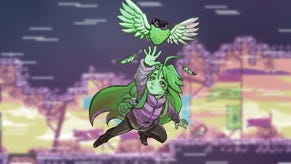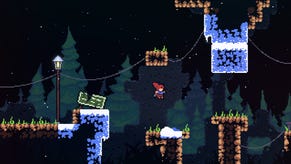How Celeste Was Designed With Speedrunning in Mind
The sound designer behind Celeste tells us how the team approached building internal speedrunning tools.
This article first appeared on USgamer, a partner publication of VG247. Some content, such as this article, has been migrated to VG247 for posterity after USgamer's closure - but it has not been edited or further vetted by the VG247 team.
Back when I reviewed Celeste well over a year ago (time sure flies), one thing I remember sticking out to me was its tools for speedrunning. From its technical polish, its carefully placed exploits, to its helpful timer for speedrunning, Celeste was geared up for many Games Done Quicks to come before it even shipped.
Backstage at the DICE Awards in Las Vegas, Nevada a couple weeks ago, after accepting the award for Best Action Game against the likes of Call of Duty: Black Ops 4 and Far Cry 5, Celeste sound designer (and creative director of Power Up Audio) Kevin Regamey spoke with USG about creating the platformer with speedrunning as the focus. It was a hand in the development process that was "a lot of me, actually," even with his sound designer position.
"I'm a big speedrunner, I love glitch hunting, finding the seams in development," Regamey says. "So we broke the game in half over and over again leading up to the release of the game. On a broad perspective, I think that we're definitely big fans of allowing players to kind of interpret the media how they see fit. So if it comes down to something like Ocarina of Time, you play it through on your casual playthrough and, if you're gonna never [play again], that's fine. If you play it like 10,000 times and your best time is like 20 minutes because you just break it in half, that's fine too."
Most notably, Celeste features an internal speedrunning timer and secret paths for speedrunners to discover. With its deceptively simple mechanics, even robots are speedrunning it (as you can watch above). When the Celeste team decided to pursue a speedrunning direction, it had three core pillars.
"One, that casual playthroughs work and be wonderful. Two, let speedrunners break it and have a good time and just toil out for them. And also not just allow for it, but like design around it. [...] So if you know the trick, you can skip this part of the room. And then also trying to bridge that gap, so people that may not have done speedruns in the past, and might feel empowered to try for the first time."

Celeste has found life far beyond 2018's end of the year discussions in the lively speedrunning community. At the time of writing this, it rests alongside the recent Resident Evil 2 remake, Super Mario 64, The Legend of Zelda: A Link to the Past, Super Mario World, and Super Metroid on Speedrun.com, a central hub for cataloguing speedrunning communities. At biannual Games Done Quick events, it's already become a staple among visiting speedrunners.
Where Regamey was once a hobbyist hunting for glitches for fun, now players of Celeste are the ones glitch and speedrun-route hunting. There's no denying it's become a huge part of Celeste's success.
"I like to think that's why we're so highly rated with Speedrun.com, like up with Mario 64 and the greats. We've just seen so many tweets of people saying, 'oh, we're going to try speedrunning for the first time.' It warms my heart."









